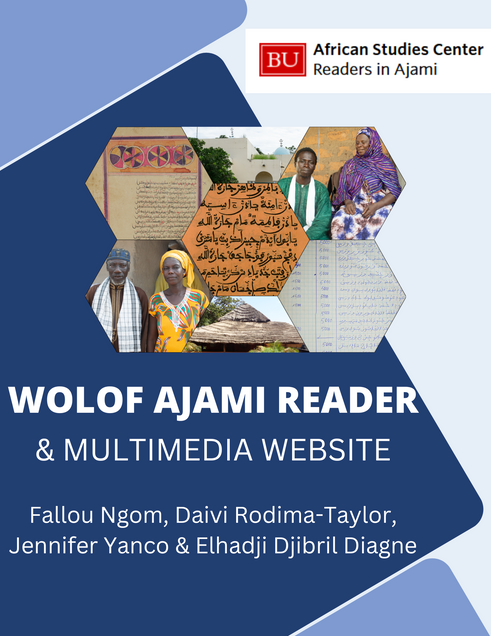New Ajami Readers and Multimedia Tools
 Our Readers in Ajami project has developed important learning resources in African Ajami, featuring a multimedia interactive website and the 200-page Wolof Ajami Reader, the first in a series of three planned Ajami Readers. The project is conducted with a grant from the U.S. Department of Education. These resources aim to bring greater visibility to African literatures written in Ajami, addressing the historical gap in access to this wealth of knowledge about Africa’s history, politics, and cultural traditions.
Our Readers in Ajami project has developed important learning resources in African Ajami, featuring a multimedia interactive website and the 200-page Wolof Ajami Reader, the first in a series of three planned Ajami Readers. The project is conducted with a grant from the U.S. Department of Education. These resources aim to bring greater visibility to African literatures written in Ajami, addressing the historical gap in access to this wealth of knowledge about Africa’s history, politics, and cultural traditions.
Our specialized Ajami Readers—covering Wolof, Mandinka, and Hausa, three major African languages with rich Ajami traditions—are designed to equip students, teachers, scholars, and professionals with the skills necessary to engage with the Ajami literary traditions of West Africa. These resources offer an in-depth look into a wide range of fields, including business, health, agriculture, human rights, and politics, making them especially valuable for understanding the increasingly influential Muslim societies of the Sahel region.
The Wolof Ajami Reader is authored by Fallou Ngom, Daivi Rodima-Taylor, Jennifer Yanco, and Elhadji Djibril Diagne. It is developed from manuscripts and interviews collected in Senegal and focuses on promoting literacy, oral proficiency, and cultural knowledge. The Reader contains six thematic units with biographical information and images of the authors or discussants of the manuscripts, the texts in Wolof Ajami with Latin-script transcriptions and English translations, images of Ajami user communities, glossaries and notes, and pedagogical exercises.
The Reader Units are complemented by their corresponding Wolof Ajami video interviews on the project website, containing video clips with Latin-script and English subtitles, metadata with information about the videos and contributors, Ajami user-community images with Latin-script and English captions, glossaries and notes, and pedagogical exercises. This multimedia resource gives the users access to interactive tools such as an embedded Wolof Ajami keyboard for practice.
The Reader also serves as a template for creating similar resources in other African languages that utilize Ajami scripts, bridging the gap between local writing traditions and the widely-used Latin script. It provides a model for building sustainable digital educational materials that incorporate the overlooked yet invaluable local knowledge contained in Ajami documents.
You can find more updates on our African Ajami projects in our recent news article on the BU African Studies Center website.
See related content